The Allure Of Titanic-Era Women’s Fashion
When it comes to the Titanic, people often think of its tragic sinking and the loss of thousands of lives. However, there’s another fascinating aspect of that era: the fashion worn by women.
From 1910 to 1912, known as the Titanic Era or Pre-World War I Era, women’s fashion was changing. This period marked the end of the Edwardian Era, which featured soft, feminine styles with flowing skirts, ruffles, lace, and S-bend corsets. During the Titanic era, elegant gowns with intricate details began to replace the more restrictive Victorian styles.
The clothes reflected a society on the brink of change that blends the old with the new in captivating ways. Let’s explore the styles that defined women’s wardrobes during this historic time.
Corset
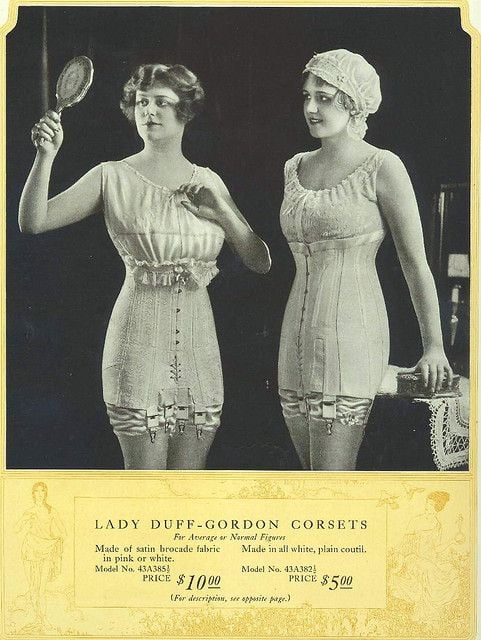
Beneath their gowns, women wore corsets designed to create a smooth, column-like shape. These corsets started under the bust and extended over the hips, focusing more on smoothing the hips than squeezing the waist.
They often had front busk closures and lacing in the back or side front. Some longer corsets had elastic panels below the waist for sitting comfortably.
To further slim their silhouette, women wore combinations or long princess line chemises underneath. “Bust bodices” or “brassieres’ ‘ added extra support. They could be boned or unboned for different levels of support.
Women with smaller busts used bust improvers or bust ruffles, which were lace-trimmed garments worn over the corset to fill out the blouse. Underwear was decorated with flat bows and lace bands to keep a smooth look.
Morning dress
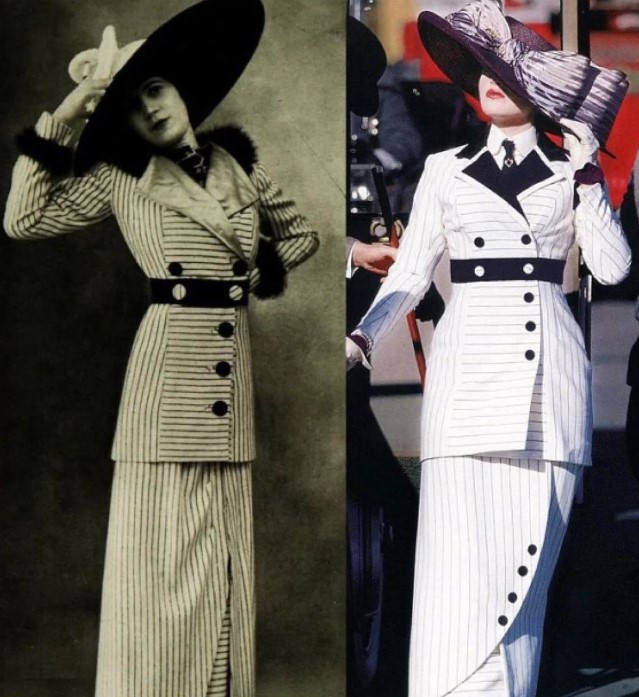
Tailor-made suits first appeared in the 1880s, typically made from tweed, face-cloth, or worsted wool. These suits were designed to fit perfectly. A standard suit included a straight-line hobble skirt, a jacket, and a crisp white blouse.
Hobble skirts were very restrictive because they narrowed at the ankles, making it hard to walk. To make movement easier, women added flat pleats or slits at the hemline. The hemline also rose to ankle height.
Jackets during this time were long and loose, extending below the hips, and often cut asymmetrically. They came in muted colors like brown, grey, and navy.
Under these jackets, women wore white blouses with many tucks and ruffles, featuring the high Edwardian collars stiffened with wires. Later, lower collars like the Quaker girl and Peter Pan styles became popular, thanks in part to Lady Duff Gordon’s influence.
Evening gown
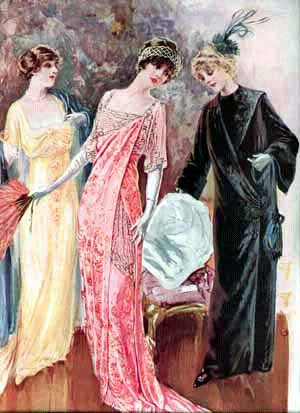
Evening dresses during the Titanic era were elegant and delicate. They were made from sheer fabrics adorned with beads, lace, or other decorations, often layered over silk. These dresses typically featured an underdress with a matching bodice and overskirt that create a tunic effect.
Bodices had short sleeves and various necklines: V, round, square, and crossover styles. Waistlines could be placed anywhere between just under the bustline and the natural waist, with high waistlines being popular from 1908 to 1912.
The waistlines were loosely defined, often accented with a sash or belt. Most dresses had two skirts: a fuller tunic skirt ending between the low hip and knees, and a slim, ankle-length underskirt.
Evening gowns had hidden elements that were crucial to their structure: the bodice lining and the staybelt. Despite looking diaphanous and draped, they were actually supported by a fitted cotton bodice lining, often boned, which kept the fabrics in place.

The gowns were made with light or sheer fabrics for the top layer, and a more solid fabric for the underskirt. Fabrics used included organdy, charmeuse, chiffon, tulle, crepe, crepe de chine, and lightweight velvet, velveteen, satin, and brocade.
Common colors for evening gowns were pale shades like steel blue, pale blue, lemon yellow, cream, pink, and white. However, the influence of orientalism introduced bolder colors like black, royal blue, and emerald.
Purple was usually avoided because it looked brown under gaslight. The oriental influence was especially noticeable in the styles and trimmings of these gowns.
Accessories
Parasols

A parasol is a must-have accessory for a fashionable outfit during the Titanic Era. These delicate, feminine items served a practical purpose by shielding women from the sun.
In that time, fair skin indicated wealth and status, suggesting that the person did not work outdoors. While parasols were functional, they also needed to reflect the carrier’s wealth.
Though plain designs were available, wealthy women often chose parasols made of luxurious lace to showcase their status.
Hats
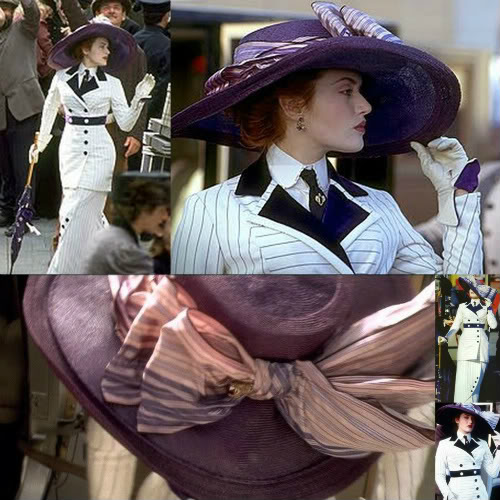
Hats played a significant role in social etiquette, and virtually all women wore them during this time. By 1910, hats had reached their peak in size and extravagance, though they were still quite decorated and relatively big.
Even with the more practical tailor-made suits, women often opted for elaborate hats with their outfits.
Feathers, especially ostrich, were a popular embellishment, along with aigrette and birds-of-paradise plumage. Silk and velvet ribbons in darker shades also adorned many hats, adding to their elegance and style.
Gloves
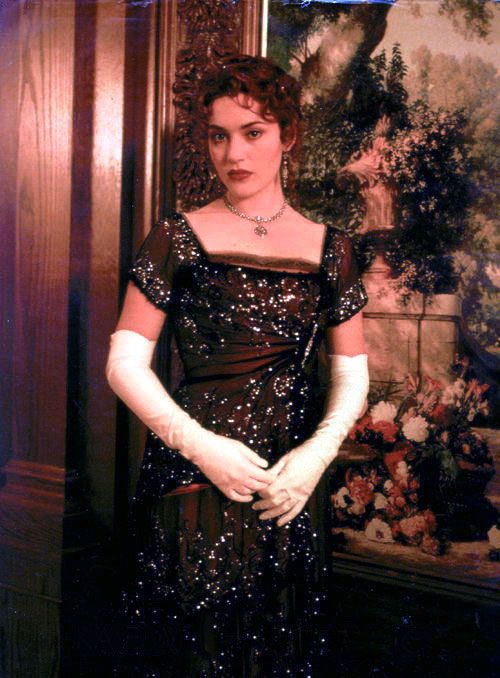
In 1992, fashion was starting to show signs of progress, but traditional societal norms still dictated many aspects of women’s behavior.
Among the upper class, it was considered improper for women to touch anyone in public. As a result, gloves were a must-have accessory at all times, except during meals or special occasions.
These gloves were often white or ivory, extending past the elbow or stopping at the wrist if the gown had long sleeves. Like all clothing of the time, gloves were meticulously crafted, often adorned with intricate buttons.
Despite the elegance they added, putting on these gloves was a time-consuming task, sometimes taking up to twenty minutes due to their snug fit and multiple button closures. They needed to be changed frequently throughout the day to keep them clean.
Shoes
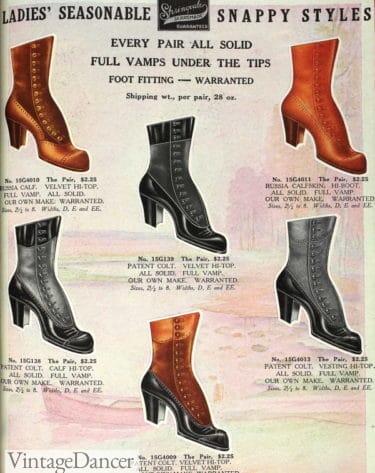
During the late Edwardian era in the 1910s, women’s footwear showcased a variety of unique boots and shoes reminiscent of Victorian styles. Popular choices included brown or black leather boots that reached mid-calf, fastened with either laces or buttons to secure them snugly.
These boots typically featured pointed or gently rounded toes and were adorned with low French heels, adding a touch of grace and sophistication to the wearer’s ensemble.

